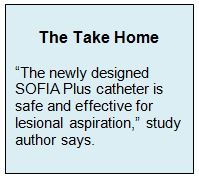Key Points:
- Study assesses the SOFIA Plus catheter for recanalization of acute ischemic stroke
- High rates of rapid recanalization achieved, with complications similar to other devices
The newly redesigned SOFIA Plus catheter is helping European interventionalists achieve a high rate of recanalization for acute ischemic stroke quickly and often in one pass, according to a study published online December 20, 2016, ahead of print in the Journal of NeuroInterventional Medicine.
Markus Möhlenbruch, MD, of Heidelberg University Hospital (Heidelberg, Germany), and colleagues conducted a retrospective analysis of prospectively collected data from 6 university hospitals in Germany and Austria on 85 patients with acute ischemic stroke treated using the direct aspiration first pass technique (ADAPT) with the SOFIA Plus catheter (MicroVention, Tustin, CA).
The key feature that differentiates the SOFIA from other catheters is its inner luminal diameter, which at 0.07 inches is currently the widest on the market. “Another publication has shown that aspiration catheters with a larger inner luminal diameter offer a higher aspiration flow rate and, in addition, a greater force of aspiration at the catheter tip,” Dr. Möhlenbruch told Neurovascular Exchange in an email. He also noted that the catheter has a particularly soft and flexible tip, which can prevent complications during catheter positioning and facilitate navigation into distal vessels.
All patients were treated between June 2015 and January 2016. The occlusion site was in the anterior circulation 94.1% of the time, and patients’ median baseline NIHSS score was 18. ADAPT was feasible in 64.7% of cases, with a median procedure time of 21 minutes. In the remaining cases, stent retrievers were used, and the final overall rate of complete recanalization (TICI score ≥ 2b) was 96.5%.
Overall, outcomes were positive and complications were in line with published data on other devices (table 1).
Table 1. Complications and Outcomes
|
|
n = 85 |
|
Catheter-Related Complications (Including Dissection) |
0% |
|
Thrombus Migration to New Vascular Territory |
4.7% |
|
Symptomatic Hemorrhage |
4.7% |
|
90-Day mRS 0-2 |
49.4% |
|
90-Day Mortality |
20% |
Adoption Fueled by Rapid Clot Removal Capability
According to Dr. Möhlenbruch, the SOFIA Plus catheter is being increasingly used in high-volume stroke centers in Germany and Austria primarily because it allows for rapid clot removal. Like any similar device, however, its use is associated with some risks, including the potential for vessel dissection related to catheter positioning within the occluded vessel. Fortunately, complication rates in this series were low.
“In a few patients (8.2%), positioning of the SOFIA Plus catheter within the target vessel failed due to difficult anatomical conditions (tortuous vessels with hindered passage of the ophthalmic artery origin),” he said, “but even in these cases no dissections occurred.”
The typical risks associated with interventional stroke procedures—complications at the puncture site, symptomatic intracranial hemorrhage, and thrombus migration into a new vascular territory —all occurred at similar rates as those seen with other devices.
In addition to demonstrating the safety and efficacy of the SOFIA Plus, Dr. Möhlenbruch told NVX that their study also introduced a new thrombus removal technique. “The so-called thrombus-no-touch technique (TNT) was successfully used in 56.5% of a subgroup of patients,” he said. “TNT [involves] positioning of SOFIA Plus within the proximal part of the thrombus without the need to cross the occlusion with the microwire/catheter system. No directly catheter-related complications such as dissections occurred.”
Source:
Möhlenbruch MA, Kabbasch C, Kowoll A, et al. Multicenter experience with the new SOFIA Plus catheter as a primary local aspiration catheter for acute stroke thrombectomy. J NeuroInterv Surg. 2016;Epub ahead of print.
Disclosures:
Dr. Möhlenbruch reports receiving consulting honoraria, speaker honoraria, and travel support outside this work from Codman, Covidien, MicroVention, Phenox, and Stryker.


